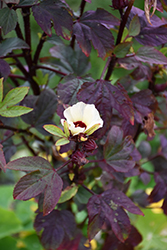Fri & Sat 8am - 8pm
Sun 8am - 7pm
Anytown, USA 12345
fax: 261.787.0463
e-mail: info@successgc.com


Plant Finder

Thai Red Roselle
Hibiscus sabdariffa 'Thai Red'
Height: 4 feet
Spacing: 3 feet
Sunlight:
![]()
![]()
Hardiness Zone: 8a
Other Names: Florida Cranberry, Thai Red Hibiscus
Description:
Bold and beautiful, this tender perennial turns heads with its red stems, bright red calyces and bold creamy yellow flowers; calyces can be harvested to create zingy teas, sauces, syrups or jams; young leaves are edible with a tangy citrus flavor
Edible Qualities
Thai Red Roselle is a perennial herb that is typically grown for its edible qualities, although it does have ornamental merits as well. It produces ruby-red flowers which are typically harvested when mature. The flowers have a tangy taste.
The flowers are most often used in the following ways:
- Eating When Cooked/Prepared
- Preserves
- Sauces
- Tea
Features & Attributes
Thai Red Roselle features bold buttery yellow round flowers with dark red eyes at the ends of the stems from mid summer to early fall. Its attractive large pointy leaves remain green in color with distinctive dark red veins and tinges of burgundy throughout the season. The ruby-red stems are very colorful and add to the overall interest of the plant.
This is an herbaceous perennial herb with an upright spreading habit of growth. Its relatively coarse texture can be used to stand it apart from other garden plants with finer foliage. This plant will require occasional maintenance and upkeep, and should be cut back in late fall in preparation for winter. It is a good choice for attracting butterflies and hummingbirds to your yard. It has no significant negative characteristics.
Aside from its primary use as an edible, Thai Red Roselle is sutiable for the following landscape applications;
- Accent
- Mass Planting
- General Garden Use
- Naturalizing And Woodland Gardens
Planting & Growing
Thai Red Roselle will grow to be about 4 feet tall at maturity, with a spread of 24 inches. When grown in masses or used as a bedding plant, individual plants should be spaced approximately 3 feet apart. It grows at a fast rate, and under ideal conditions can be expected to live for approximately 5 years. As an herbaceous perennial, this plant will usually die back to the crown each winter, and will regrow from the base each spring. Be careful not to disturb the crown in late winter when it may not be readily seen!
This plant is quite ornamental as well as edible, and is as much at home in a landscape or flower garden as it is in a designated herb garden. It does best in full sun to partial shade. It requires an evenly moist well-drained soil for optimal growth, but will die in standing water. This plant should not require much in the way of fertilizing once established, although it may appreciate a shot of general-purpose fertilizer from time to time early in the growing season. It is not particular as to soil pH, but grows best in sandy soils. It is highly tolerant of urban pollution and will even thrive in inner city environments. Consider applying a thick mulch around the root zone in winter to protect it in exposed locations or colder microclimates. This is a selected variety of a species not originally from North America. It can be propagated by cuttings; however, as a cultivated variety, be aware that it may be subject to certain restrictions or prohibitions on propagation.
